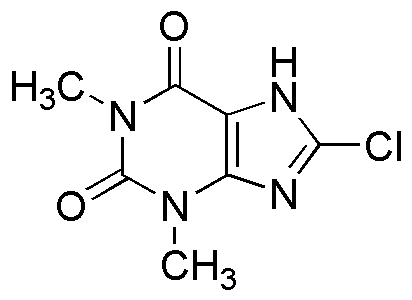8-Chlorotheophylline is widely utilized in research focused on:
- Pharmaceutical Development: This compound serves as a valuable intermediate in the synthesis of various pharmaceuticals, particularly those targeting respiratory conditions, enhancing drug formulation efficiency.
- Research on Caffeine Metabolism: It is used in studies investigating the metabolism of caffeine and its effects on human health, providing insights into dietary impacts and potential therapeutic uses.
- Analytical Chemistry: 8-Chlorotheophylline is employed as a reference standard in analytical methods such as HPLC, aiding researchers in the accurate quantification of related compounds in complex mixtures.
- Botanical Studies: This compound is utilized in botanical research to explore the effects of chlorinated purines on plant growth and development, contributing to agricultural science.
- Neuroscience Research: It is investigated for its potential neuroprotective effects, offering possibilities for developing treatments for neurodegenerative diseases.
Informations générales
Propriétés
Sécurité et réglementation
Applications
8-Chlorotheophylline is widely utilized in research focused on:
- Pharmaceutical Development: This compound serves as a valuable intermediate in the synthesis of various pharmaceuticals, particularly those targeting respiratory conditions, enhancing drug formulation efficiency.
- Research on Caffeine Metabolism: It is used in studies investigating the metabolism of caffeine and its effects on human health, providing insights into dietary impacts and potential therapeutic uses.
- Analytical Chemistry: 8-Chlorotheophylline is employed as a reference standard in analytical methods such as HPLC, aiding researchers in the accurate quantification of related compounds in complex mixtures.
- Botanical Studies: This compound is utilized in botanical research to explore the effects of chlorinated purines on plant growth and development, contributing to agricultural science.
- Neuroscience Research: It is investigated for its potential neuroprotective effects, offering possibilities for developing treatments for neurodegenerative diseases.
Documents
Fiches de données de sécurité (FDS)
La FDS fournit des informations de sécurité complètes sur la manipulation, le stockage et l’élimination du produit.
Spécifications du produit (PS)
Le PS fournit une description complète des propriétés du produit, notamment sa composition chimique, son état physique, sa pureté et les exigences de stockage. Il détaille également les plages de qualité acceptables et les applications prévues du produit.
Certificats d'analyse (COA)
Recherchez des certificats d'analyse (COA) en saisissant le numéro de lot du produit. Les numéros de lot et de lot se trouvent sur l'étiquette d'un produit, après les mots « Lot » ou « Lot de fabrication ».
Numéro de catalogue
Numéro de lot/série
Certificats d'origine (COO)
Ce certificat d'exploitation confirme le pays dans lequel le produit a été fabriqué, et détaille également les matériaux et composants utilisés et s'il est issu de sources naturelles, synthétiques ou autres sources spécifiques. Ce certificat peut être requis pour les douanes, le commerce et la conformité réglementaire.
Numéro de catalogue
Numéro de lot/série
Fiches de données de sécurité (FDS)
La FDS fournit des informations de sécurité complètes sur la manipulation, le stockage et l’élimination du produit.
DownloadSpécifications du produit (PS)
Le PS fournit une description complète des propriétés du produit, notamment sa composition chimique, son état physique, sa pureté et les exigences de stockage. Il détaille également les plages de qualité acceptables et les applications prévues du produit.
DownloadCertificats d'analyse (COA)
Recherchez des certificats d'analyse (COA) en saisissant le numéro de lot du produit. Les numéros de lot et de lot se trouvent sur l'étiquette d'un produit, après les mots « Lot » ou « Lot de fabrication ».
Numéro de catalogue
Numéro de lot/série
Certificats d'origine (COO)
Ce certificat d'exploitation confirme le pays dans lequel le produit a été fabriqué, et détaille également les matériaux et composants utilisés et s'il est issu de sources naturelles, synthétiques ou autres sources spécifiques. Ce certificat peut être requis pour les douanes, le commerce et la conformité réglementaire.


